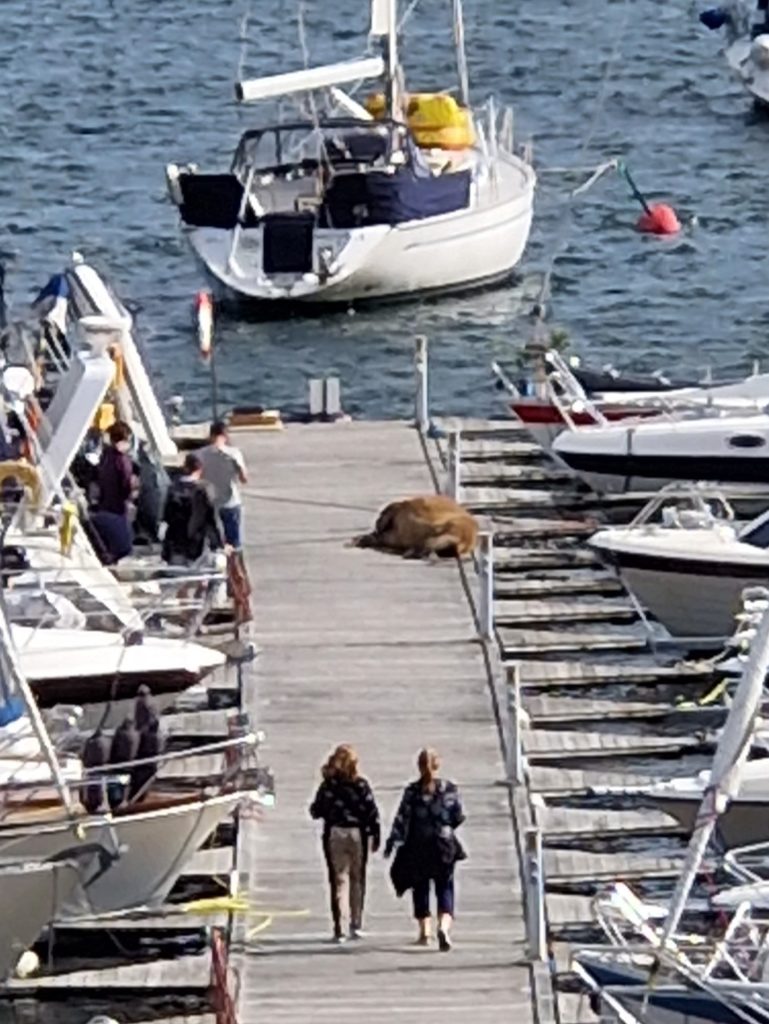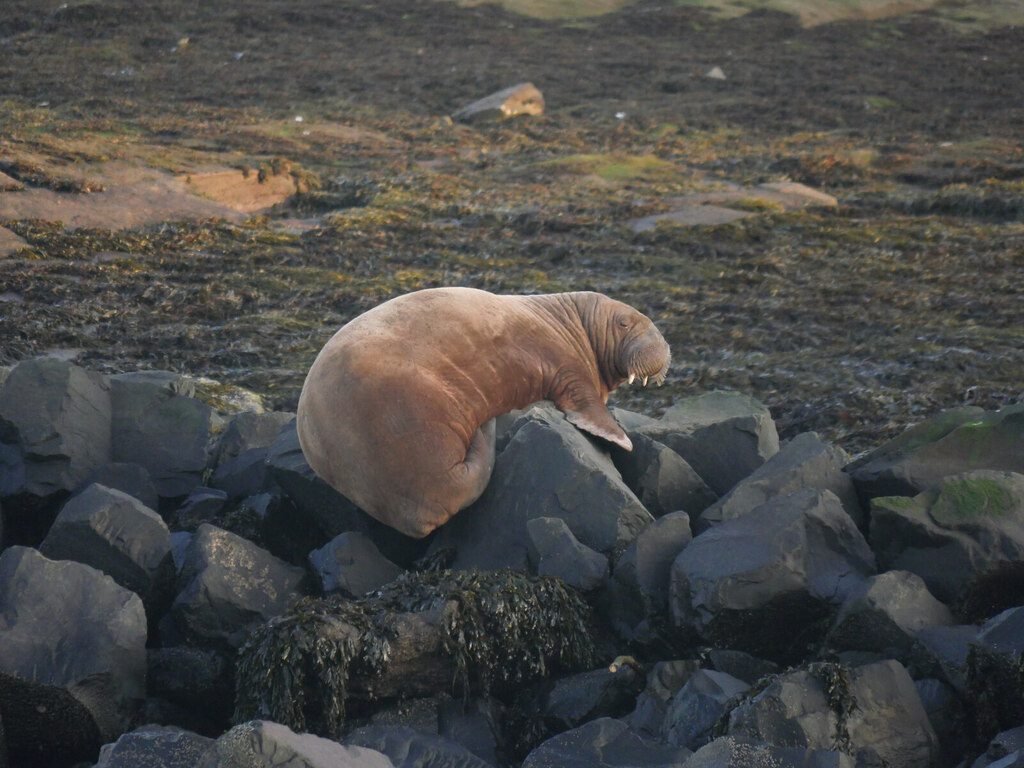This week, Freya, a 600-kilogram walrus, had to be euthanized in Norway after repeated encounters with humans put her safety—and that of onlookers—at risk. She had wandered alone into the Oslo Fjord, a busy waterway populated by boaters, paddleboarders, kayakers, and sunbathers. Freya had become a local celebrity, complete with a Facebook fan page and regular updates about her location.
It was unclear just why she had arrived. Walruses are social animals—perhaps she was seeking companionship and felt more comfortable around humans than alone in the sea.
No matter what drove her to this decision, however, the decision to end her life was one made by humans. “In the end, we couldn’t see any other options,” said a spokesman for the Norwegian Directorate of Fisheries, Olav Lekver. “She was in an area that wasn’t natural for her.” 1The New York Times “A Walrus Named Freya Showed Up in Norway. Did She Have to Die?“
Walruses in nature can swim quickly up to a mass of floating ice, heaving their giant bodies onto it as it tilts under their weight. Repeating this natural behavior, Freya swam up and launched her body onto small boats in the fjord.
The thing that made much of Freya’s location and behavior no longer “natural for her” wasn’t anything she had done. It was humans. It was not so much Freya who did not belong, floating in this salt-water fjord on a peninsula that, further north, is home to reindeer and polar bears. It was humans.
We are waking up to many terrible consequences of this relationship of dominance. We are seeing creatures die that many would say could and should be allowed to live.
Stories of animals being euthanized or trapped and relocated are nothing new. Countless numbers of smaller creatures are killed without media attention as humans encroach on new territories. Many more die off as we decimate habitats and cut off migration corridors.

It is usually only when larger, attractive animals—known as charismatic megafauna—are caught up in this predicament that we take notice. We recall stories of whales and dolphins swimming into waters made dangerously unclean by humans. There are tales of bears in North America becoming dependent on the trash of campers and picnickers for food. Quite often, we hear about the animals dying. But other times we hear about heroic rescues or relocations. Usually, we are not told much about the causes and conditions that lead to these tragedies or happy outcomes.
This is problematic. For, as Buddhism teaches, causes and conditions are of great importance. We know that if we throw a mango seed into a garbage dump, we will not get a peach tree. Our cause—the mango seed—and the conditions—a garbage dump—are not conducive to growing a peach tree.
Similarly, if we as a species continue to consume the Earth’s resources voraciously and produce voluminous quantities of waste, including mountains of plastic in our oceans and tonnes of carbon dioxide in our atmosphere, then we are setting into place the causes and conditions for our own demise as a species. Along the way, those causes and conditions will generate immense suffering as future generations try to survive in a world in which food and water systems are no longer safe and clean. Beyond this, we will generate further causes and conditions for more non-human animals to needlessly suffer and die in places and situations that we might deem to be “not natural” for them.
While some of the world’s religions and philosophical systems might suggest that this drive to destroy is simply “human nature,” Buddhism teaches us that what is called human nature is a highly malleable thing. To be human is to have a body which will face old age, sickness, and death. And a commonality of all but the perfectly awakened humans out there is at least some greed, aversion, and ignorance. But just how much of these “three poisons” or three roots of unskillful behavior we might possess as individuals or as entire societies can change greatly over time.
Equally importantly, a Buddhist idea of human nature must also include our ability to overcome these traits entirely, to cultivate virtues and to develop societies that give rise to peace, harmony, and sustainability in the place of our world dominated by war, distrust, and rampant consumption.
It should be clear that participating in contemporary society requires a large degree of what Buddhism terms “wrong view.” We eat processed foods, ride in cars and aircraft, and consume mass media with no compassion for the ignorance promulgated or the beings harmed in our doing so. “Right view,” by contrast, is rooted in compassion for all beings, asking always how our thoughts, words, and deeds might reduce suffering.
Right view might also direct us toward the other three Brahma-viharas (Divine abodes): loving-kindness, sympathetic joy, and equanimity. How might the Norwegian encounter with Freya have differed if individuals and officials had these virtues in mind?
Can I enjoy seeing the great animals of the world from a safe distance, for their sake and my own? … perhaps I don’t need to see them at all.

Dan Jarvis, director of welfare and conservation at British Divers Marine Life Rescue, a charity based in England, provides one example of a more thoughtful and compassionate approach. Last year, another walrus—this one named Wally—spent several weeks off the coast of southwest England. The area, like the Oslo Fjord, was crowded with boats and tourists. Rather than seeing the walrus as a danger or problem to be dealt with, local authorities provided Wally with his own platform to swim up on to rest.
Jarvis and local officials in England applied wisdom to provide their wayward walrus with a simple item to satisfy its needs, negating any problems it might have caused. Instilling greater respect and reverence for wildlife on a social level could help immensely as well, allowing equanimity to arise in the public when an exciting new creature wanders into human-filled territories. Too often, the worst instincts arise in people with little wisdom who then make quick—and often disastrous—decisions.
Those of us with little understanding of animals and the deep complexity of changing ecosystems would do well to practice humility. This would go “against the stream” of much contemporary culture, which pushes individuals to conquer nature—valorizing the mountain-top photos, the rugged off-road vehicles, and even, for many, the safari images with rifle in hand beside a newly killed elephant, giraffe, or rhinoceros. Fortunately, the notion of a photo-safari—where tourists simply “shoot” cameras and “capture” memorable photos—is a growing alternative to the archaic and cruel practice of killing majestic animals for fur, ivory, or “sport.”
This humility could aid us in our slowing down in life in general. Do we need to fly internationally four times a year? Could it be three times, or twice, or once, or not at all? Do we need to eat meat regularly? Could it be scaled back to special occasions or none at all? Can I enjoy seeing the great animals of the world from a safe distance, for their sake and my own? Or, again, perhaps I don’t need to see them at all. These questions are all asked by many of us as concerned citizens seeking to be responsible consumers. But we urgently need them to be asked more broadly and at more deeply structural levels of society.
Our relationship with nature is largely one of dominance. We, after all, have the power to reshape it, to remove mountains, to kill off creatures large and small, and to mold the world to suit our whims. And yet, we are waking up to many terrible consequences of this relationship of dominance. We are seeing creatures die that many would say could and should be allowed to live. And with entire species of animals falling into or near extinction, we’re realizing that our extraordinary power comes at an extraordinary cost, one that could lead to our own demise.
This article was originally published on Buddhistdoor Global. It is reprinted here with permission.
References
- 1The New York Times “A Walrus Named Freya Showed Up in Norway. Did She Have to Die?“







